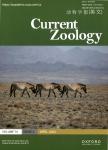GPS tracking of non-breeding ravens reveals the importance of anthropogenic food sources during their dispersal in the Eastern Alps
GPS tracking of non-breeding ravens reveals the importance of anthropogenic food sources during their dispersal in the Eastern Alps作者机构:Department of Cognitive Biology University of Vienna Althanstrasse 14 A-1090 vienna Konrad Lorenz Forschungsstelle Core Facility for Behaviour and Cognition University of Vienna Fischerau 11 A-4645 GrLinau im Almtal Austria CDepartment of Forest and Conservation Sciences University of British Columbia Vancouver B.C. Canada V6T1Z4
出 版 物:《Current Zoology》 (动物学报(英文版))
年 卷 期:2016年第62卷第4期
页 面:337-344页
核心收录:
学科分类:0710[理学-生物学] 07[理学] 09[农学]
基 金:funded by the Austrian Science Fund (FWF) Projects
主 题:common raven Corvus corax non-breeder space use dispersal kernel density.
摘 要:In many songbirds, the space use of breeders is well studied but poorly understood for non-breeders. In common ravens, some studies of non-breeders indicate high vagrancy with large individual differences in home range size, whereas others show that up to 40% of marked non-breeders can be regularly observed at the same anthropogenic food source over months to years. The aim of this study was to provide new insights on ravens' behavior during dispersal in the Eastern Alps. We deployed Global Positioning System (GPS) loggers on 10 individuals to gather accurate spatial and temporal information on their movements to quantify: 1) the dimension of the birds' space use (home range size with seasonal effects and daily/long-term travel distances), 2) how long they stayed in a dispersal stage of wandering as opposed to settling temporarily, and 3) their destination of movements. We recorded movements of up to 40km per hour, more than 160km within 1 day and more than 11,000 km within 20 months, indicating high vagrancy. Switching frequently between temporarily settling and travelling large distances in short time intervals leads to extensive home ranges, which also explains and com- bines the different findings in the literature. The destinations are rich anthropogenic food sources, where the birds spent on average 75% of their time. We discuss how ravens may find these "feeding hot spots" and which factors may influence their decision to stay/leave a site. The strong dependence on anthropogenic resources found in this population may have implications for site management and conservation issues.



